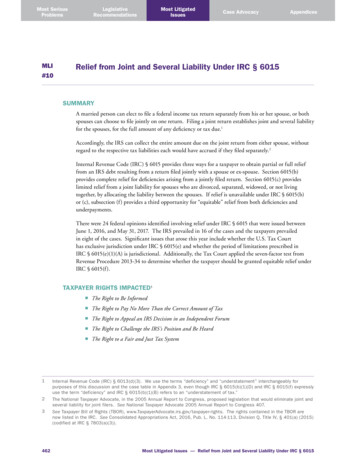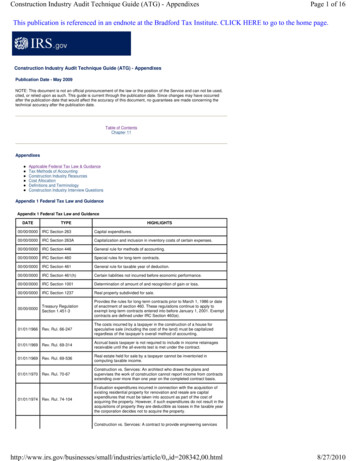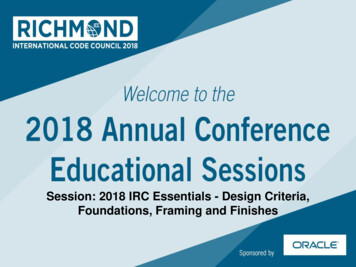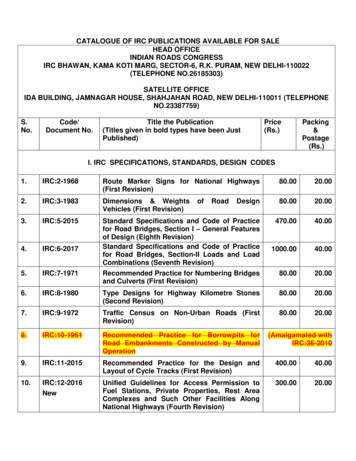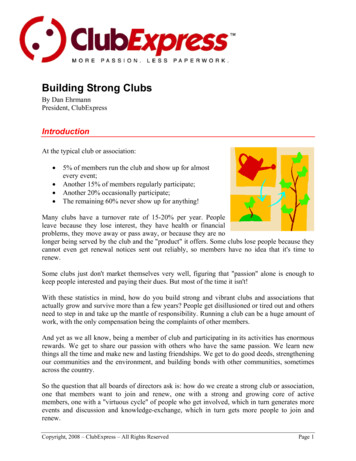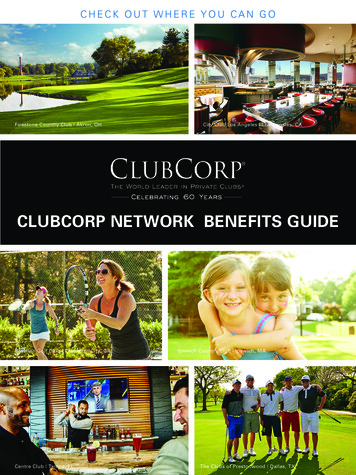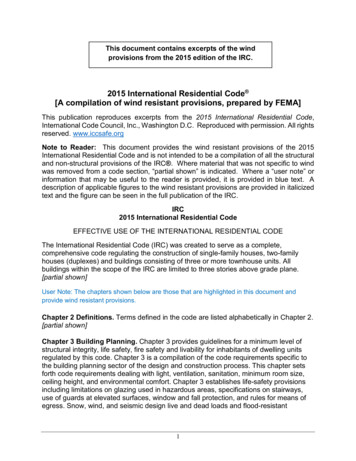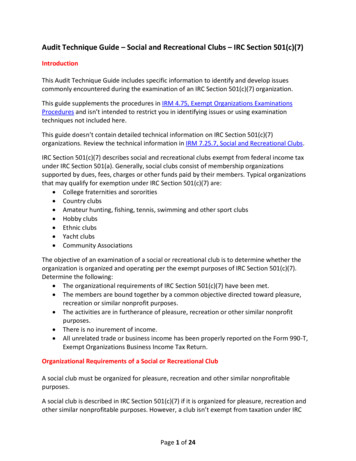
Transcription
Audit Technique Guide – Social and Recreational Clubs – IRC Section 501(c)(7)IntroductionThis Audit Technique Guide includes specific information to identify and develop issuescommonly encountered during the examination of an IRC Section 501(c)(7) organization.This guide supplements the procedures in IRM 4.75, Exempt Organizations ExaminationsProcedures and isn’t intended to restrict you in identifying issues or using examinationtechniques not included here.This guide doesn’t contain detailed technical information on IRC Section 501(c)(7)organizations. Review the technical information in IRM 7.25.7, Social and Recreational Clubs.IRC Section 501(c)(7) describes social and recreational clubs exempt from federal income taxunder IRC Section 501(a). Generally, social clubs consist of membership organizationssupported by dues, fees, charges or other funds paid by their members. Typical organizationsthat may qualify for exemption under IRC Section 501(c)(7) are: College fraternities and sororities Country clubs Amateur hunting, fishing, tennis, swimming and other sport clubs Hobby clubs Ethnic clubs Yacht clubs Community AssociationsThe objective of an examination of a social or recreational club is to determine whether theorganization is organized and operating per the exempt purposes of IRC Section 501(c)(7).Determine the following: The organizational requirements of IRC Section 501(c)(7) have been met. The members are bound together by a common objective directed toward pleasure,recreation or similar nonprofit purposes. The activities are in furtherance of pleasure, recreation or other similar nonprofitpurposes. There is no inurement of income. All unrelated trade or business income has been properly reported on the Form 990-T,Exempt Organizations Business Income Tax Return.Organizational Requirements of a Social or Recreational ClubA social club must be organized for pleasure, recreation and other similar nonprofitablepurposes.A social club is described in IRC Section 501(c)(7) if it is organized for pleasure, recreation andother similar nonprofitable purposes. However, a club isn’t exempt from taxation under IRCPage 1 of 24
Section501(a) if the club has any written policy that discriminates based on race, color, orreligion. See IRC Section501(i). The previous statement doesn’t apply in the followingcircumstances: Auxiliaries of IRC Section 501(c)(8) fraternal beneficiary societies may limit theirmembership to the members of a particular religion under IRC Section 501(i)(1). A club may in good faith limits its membership to the members of a particular religion inorder to further its teachings or principles, and not to exclude individuals of a particularrace or color under IRC Section 501(i)(2). A club's governing instruments may limit its membership to individuals of a particularnational origin without jeopardizing its exemption. A club may restrict its membership to a particular political party or to homeowners in aspecific housing development.Note: Although membership may be restricted to a particular political party or to homeownersin a specific housing development, these organizations aren’t permitted to also limitmembership based on race, color, or religion.Auditing Organizational Requirements of a Social or Recreational Club Review the following governing instruments including:o Articles of organizationo Bylawso Any policy statements Determine that:o The club is organized for pleasure, recreation and other similar nonprofit purposes.o There are no activities expressly authorized that are beyond the scope of IRC Section501(c)(7).o There are no written provisions limiting membership on the basis of race, color orreligion (except as otherwise noted in IRC Section 501(i)).Note: The IRS doesn’t require an organization to have an affirmative statement ofnondiscrimination.Membership Requirements of a Social or Recreational ClubA social or recreational club must provide the opportunity for personal contact between itsmembers and the members must be bound together by a common objective of pleasure,recreation, and other nonprofitable purposes. See Rev. Rul. 74-30, 1974-1 C.B. 137.The common objective must be dedicated towards pleasure, recreation and other nonprofitable purposes. See Chattanooga Auto. Club v. Commissioner, 182 F.2d 551, 554 (6th Cir.1950) (interpreting section 101(9), the predecessor to section 501(c)(7)); see also LakePetersburg Assoc. v. Commissioner, 33 T.C.M. 259 (1974). Note: Members must share commoninterests or share goals justifying the organization’s existence.Page 2 of 24
Auditing Membership Requirements of a Social or Recreational ClubWhen auditing membership requirements, determine any prerequisite conditions or limitationsimposed on members, such as an interest in a particular hobby. Examples of socialorganizations that share a common goal or mutuality of interests could include flying andgardening clubs.To audit membership requirements:REVIEWBylaws, minutes of meetings, club handbooks,brochures, and newslettersTO DETERMINEIf members have the opportunity forfellowship, commingling, or other personalcontact. Commingling is present if things likemeetings, social gatherings, and recreationalfacilities are available for the membership.Generally, the lack of commingling ofmembers presents a red flag indicating thatthe basic purpose of the organization serves toprovide personal services and goods in amanner similar to commercial enterprises.Membership applications, club handbooks and Requirements and procedures for obtainingany brochures or other information providedmembership. Determine the types ofto prospective membersmemberships available and whether theyinclude corporations.An automobile club whose principal activity is rendering automobile services to its membersbut has no significant social activities doesn’t qualify for exemption under IRC Section 501(c)(7).Rev. Rul. 69-635, 1969-2 C.B. 126. Note: Rev. Rul. 69-635 hasn’t been updated to reflect P.L. 94568, 1976-2 C.B. 596.Likewise, a flying club which provides economical flying facilities for its members but has noorganized social and recreation program doesn’t qualify for exemption under IRC Section501(c)(7). Rev. Rul. 70-32, 1970-1 C.B. 132. Note: Rev. Rul. 70-32 hasn’t been updated to reflectP.L. 94-568.A country club that issues corporate membership is dealing with the general public in the formof the corporations' employees. Accordingly, treat corporate memberships as gross receiptsfrom a nonmember source. However, bona fide individual memberships that a corporation paidfor are indistinguishable from other individual memberships. See Rev. Rul. 74-489, 1974-2 C.B.169. Note: Rev. Rul. 74-489 hasn’t been updated for P.L. 94-568.A social club doesn’t jeopardize its exemption under IRC Section 501(c)(7) by admittingcorporation sponsored individuals who have the same rights and privileges as regular individualmembers and who must seek a membership committee’s approval. Rev. Rul. 74-168, 1974-1C.B. 139. Note: Rev. Rul. 74-168 hasn’t been updated for P.L. 94-568.Page 3 of 24
Identify any temporary memberships that allow nonmembers temporary access to memberactivities and privileges. These may be a guise around the membership rules.Operational Requirements of a Social or Recreational ClubSubstantially all of a club's activities should be devoted to pleasure, recreation and other nonprofitable purposes with members and their guests.Before 1976, IRC Section 501(c)(7) required a tax-exempt club to be organized and operated“exclusively” for pleasure, recreation, and other nonprofitable purposes. P.L. 94-568 amendedIRC Section 501(c)(7) to require that “substantially all” of a tax-exempt club’s activities arededicated for pleasure, recreation, and other nonprofitable purposes. The amendment wasintended to allow IRC Section 501(c)(7) organizations to receive up to 35 percent of their grossreceipts, including investment income, from sources outside their membership without losingtheir exempt status. See S. Rep. No. 94-1318 (1976). Within the 35 percent, no more than 15percent of gross receipts should come from the general public’s use of the social club's facilitiesor services. If an organization has outside income over the 35-percent or 15-percent limit,consider all the facts and circumstances to determine whether the organization qualifies forexempt status.Rev. Proc. 71-17, 1971 C.B. 683, lists guidelines for determining the effect of gross receipts fromnonmember use of a social club’s facilities on the club’s exemption. Rev. Proc. 71-17 describesthe circumstances under which nonmembers who use a club's facilities are presumed to beguests of members, rather than the general public. The host-guest relationship is presumed asfollows, if payment is received directly from the member or the member's employer: A group of eight or fewer individuals, and at least one of the group is a member. A group, at least 75 percent of which consists of members.Clubs that rely on either of the host-guest assumptions described above are always required tokeep adequate records to substantiate the appropriate facts.For all other occasions involving use by nonmembers, Rev. Proc. 71-17 section 4.03 requires theclub to maintain books and records of each use and the amount of income earned. Thisrequirement applies even if the member pays initially for the use. For each use, the record mustcontain the following information: Date Total number in party Total number of nonmembers in party Total charges Charges attributable to nonmembers Charges paid by nonmembers Member signed statement and information for reimbursement Member signed statement and information on employer reimbursements to membersfor charges attributable to nonmembersPage 4 of 24
Member signed statement and information on gratuitous reimbursements (or paymentsdirectly to the club) from nonmembers for the benefit of a memberCaution: Rev. Proc. 71-17 hasn’t been updated for P.L. 94-568.Auditing Operational Requirements of a Social or Recreational Club Tour the facilities noting any signs placed on club property inviting the general public topatronize its facilities or functions. Also, note the presence or absence of signs restrictingadmittance to "members only." Review admittance procedures to determine if facilities are open to the general public. Aclub should have some system in place, such as key-cards or a membership log that restrictsfacilities’ use to members and their guests. Review brochures, applications, policy statements and governing instruments to determineif membership requirements are broad or vaguely stated. Members must have a commonobjective. A club should have established membership criteria, which effectively precludesthe general public at large from becoming a member in the organization. The criteria mayinclude, for example, requiring an interest in a particular hobby or other recreationalactivity, or requiring the club's membership to select and approve new members. Review the minutes for discussions of proposed activities or restricted membership thatmay violate exempt purposes. Review the club's liquor license. Some states issue limited liquor licenses to social clubs,restricting liquor sales to club members and their guests. Review gaming license(s) noting any information that might indicate the games are open tothe public. Generally, gambling engaged in by members and guests of a social club isconsidered a recreational activity for purposes of IRC Section 501(c)(7) regardless of thelegality of the gaming activity. See Rev. Rul. 69-68, 1969-1 C.B. 153. Note: Rev. Rul. 69-68hasn’t been updated for P.L. 94-568. Review contracts with any taxable corporations. Review management contracts to identifyany relationships the club may have with the manager or management company. Closelyscrutinize agreements that state more than general administrative responsibilities. The clubmay be operated as a commercial venture if the management company establishes thedues or fees and is responsible for members’ selection and expulsion. Analyze the initiation charges or dues to ensure the amount charged is not so low that itencourages the general public to use the facilities one time or transiently. Analyze disbursements for advertising to determine if the club solicits public patronage. Review advertisements in newspapers, business phone directories, and vacation guides andother publications printed by the chamber of commerce or visitors’ bureau.Page 5 of 24
Auditing Nonmember Income of a Social or Recreational ClubDetermine the potential for nonmember income and set the audit scope in this areaaccordingly. (Nonmember income is taxable as unrelated business income. See “UnrelatedBusiness Taxable Income (UBI) for Social and Recreational Clubs” below.)Example: If the club uses key-cards to restrict entry to members only and all other factsindicate only members use the club, consider limiting the work in this area. Document yourworkpapers to adequately support your conclusion that the club doesn’t have nonmemberincome. Interview the club manager about the following:o Cash saleso Credit card saleso Availability of reservation book, banquet book, party function sheets, and other Rev.Proc. 71-17 recordso Member sponsorship of partieso Dates and seasons when club is closedo Reciprocal use of the clubo Sales of food and liquor for off-premise consumption Review income accounts that might include potential nonmember income. Commonsources include:o Cash sales. Assume that cash sales come from nonmembers if they cannot be traced tomembers.o Credit card saleso Reciprocal use of clubo Parties over eight individualso Club functions Review club records to substantiate parties in which a host guest relationship is assumed.Determine whether it has met the Rev. Proc. 71-17 requirements for a presumed host-guestrelationship.The following examples shows two situations that presume the host-guest relationship.Example: Mr. Y is a member of the X Country Club. Mr. Y hosts a small party at the club forhimself and seven friends. They play a round of golf and then eat lunch in the main diningroom. After lunch, Mr. Y signs his name and member number on a food/drink voucher(sometimes referred to as a chit). To document that the income from Mr. Y's party qualified asmember income, the club must keep records showing that there were eight persons in theparty, Mr. Y was a member in attendance, and Mr. Y paid the club for the total amount due.Most clubs simply keep the voucher, which shows the first two requirements. The member'smonthly statement shows the billing and the cash receipts will show that Mr. Y paid the bill. AsPage 6 of 24
long as Mr. Y pays the club directly, the club doesn’t have to ask Mr. Y if his friends willreimburse him because we can assume a host-guest relationship. However, if there’s evidenceshowing that Mr. Y’s friends paid the club directly, then you’d consider the income nonmemberincome.Example: The M Club holds a Memorial Day Party for its members. Members must makeadvance reservations and are billed for the number of persons in their party. Some membersbring a guest to the party. The club should retain the vouchers for the day, which show all ofthe individuals attending. Or, the club can keep the reservation sheet, which shows the numberof members and guests attending the party. As long as 75 percent or more of the personsattending the party are members and the club receives payment directly from the members,we assume a host-guest relationship. Again, as long as the members pay the club directly, theclub doesn’t need to ask if the guests reimbursed the member. Review the organization’s records for groups where the host-guest relationship isn’tassumed.The following two examples show situations where a host-guest relationship is not assumedand the club must maintain adequate records to support the club's classification of anonmember as a guest.Example: Mr. Z, Vice President of Marketing, holds a business luncheon meeting at the X Clubfor the marketing department of his company. Mr. Z is a member of the X Club, but the other25 persons in the group are not. At the end of the luncheon, Mr. Z signs his name and membernumber on the vouchers. The club manager also hands him an additional form to complete,which asks for all of the information in Rev. Proc. 71-17 section 4.03. Mr. Z completes the formand the club keeps the form with the other forms from the period. Upon audit, the EOSpecialist: verifies that the form is properly completed and that the meeting served a business,personal, or social purpose of the member.Example: Mr. A and Ms. B decide to get married at the X Club. Mr. A is a member, but Ms. B isnot. They invite 200 guests and plan to pay for the wedding themselves. After the wedding, Ms.B's parents present their gift to the newlyweds; they propose to pay for the wedding at thattime. Mr. A signs the voucher and completes the form stating that his new in-laws paid the bill.This is an example of a gratuitous payment by a nonmember. As long as the club keeps aproperly completed form, this event is considered member income because the Rev. Proc. 7117 requirement under section 4.03-9 was met to establish a host-guest relationship. Reconstruct nonmember income for cases in which the club's classification is not correct.Inspect and analyze the reservation book(s), membership rosters, party function sheets,monthly member billings, and other club records to determine nonmember income. Consider whether a club is precluded from using the minimum gross receipts standard.Audit assumptions apply to cases under Rev. Proc. 71-17 section 4.04 when records areinadequate or unavailable.Page 7 of 24
Calculate the percentage of gross receipts derived from the general public’s use of socialclub facilities or services (total nonmember gross receipts divided by total gross receipts).Total gross receipts include charges, admissions, membership fees, membership dues,member assessments and investment income. It doesn’t include unusual amounts ofincome, such as the sale of a clubhouse. See S. Rep. No. 94-1318 (1976). Calculate the percentage of gross receipts from investment income. Include set-asideincome (see “Set Aside Income of a Social or Recreational Club,” below) in this computation.See S. Rep. No. 94-1318 (1976). Apply a facts and circumstances test when a club exceeds the 15 or 35 percent limitations.Consider these factors in applying this test:o The actual percentage of nonmember receipts and/or investment income.o The frequency of nonmember use of club facilities.o The number of years exceeding the percentage.Note: Generally, view a high percentage of nonmember income in one year more favorablythan a pattern of consistently exceeding the limits. For example, a club’s high percentage ofnonmember receipts in three consecutive years is more likely to indicate that a nonexemptpurpose exists than its receiving it in one out of three years.Nontraditional Business Activities of a Social or Recreational ClubActivities that do not further a social club's exempt purpose, even if conducted based on amembership, are referred to as nontraditional business activities. A social club is prohibitedfrom conducting more than an insubstantial amount of nontraditional business activities. Theprohibition applies equally to business with members and nonmembers.To compute the gross receipts test, the Committee Reports that accompanied P.L. 94-568,1976-2 C.B. 596, state that social clubs shouldn’t receive, within the 15 or 35 percentallowances, any income from nontraditional business activities. S. Rep. No. 94-1318 (1976).When an organization's nontraditional income causes the organization to exceed the 15 or 35percent allowances, consider whether the organization continues to substantially operate forIRC Section 501(c)(7) purposes.An article on social clubs in the 1996 EO Continuing Professional Education (CPE) indicates thatthe IRS would consider nontraditional income to determine whether an organization hasexceeded the overall limits on outside income. The article states that not considering it wouldallow organizations with nontraditional income to have a greater percentage of their totalincome from unrelated activities, contrary to Congress’ intent.Income from nontraditional business activities can be a source of unrelated business income(UBI). See “Unrelated Business Taxable Income for Social and Recreational Clubs” below.Page 8 of 24
Auditing Nontraditional Business Activities of a Social or Recreational Club Tour the club's facilities noting any activities which might generate nontraditional income. Analyze the club's income to identify any revenue not generated from recreational, social orsimilar services.Examples of nontraditional income may include: Sale of package liquor for consumption off social club premises Long-term rental of rooms Take out and catering activities for consumption off social club premises Commuter use of parking facilities Advertising income Provision of personal services, such as the operation of a service station, or barber shop Determine the percentage of income the club received from nontraditional activities. Determine the effect of nontraditional activities on the club's exempt status by consideringthe percentage of nontraditional income compared to its total activities, whether thepercentage is rising and any other relevant factors. Court cases and IRS rulings haven’t set afixed standard to determine whether a club's nontraditional business activities are deemedinsubstantial.Note: The 1994 EO CPE textbook indicates that if the gross receipts from nontraditionalactivities is less than 5% of gross receipts from total activities, the club’s nontraditionalactivities would normally be insubstantial and not affect exemption. If the gross receipts fromnontraditional activities are increasing and more than 5% of gross receipts from all activities,then the organization’s exemption may be affected. This suggestion derived from analyzing thefollowing: Santa Barbara Club v. Commissioner, 68 T.C. 200 (1977) –social club that received morethan 25% of gross receipts from selling liquor to members for consumption off premises,which amounted to 7% of all gross receipts, was not exempt. G.C.M. 39115 (July 21, 1983) as modified by G.C.M. 39412 – opined that, technically,any gross receipts from a nontraditional business would require revocation, but as apractical matter it may be administratively appropriate in some cases to allowinsubstantial amounts of this type of income. TAM 9212002(Dec. 4, 1991) – social club that received 6.07% of its gross revenue (whichhad increased steadily from 4.28% over five years) from selling food to members forconsumption off premises was not exempt.Page 9 of 24
Inurement for Social and Recreational ClubsA social club can’t have any part of its net earnings inure to a shareholder or member.During the initial interview, ask whether the club manager, a director, or an officer receives apercentage of gross or net profit.Analyze distributions to identify any dividends or bonuses. IRS found that distributions ofcondemnation proceeds and fees paid to bring in new members didn’t constitute inurement tomembers. See Rev. Rul. 65-64, 1965-1 C.B. 241 and Rev. Rul. 80-130, 1980-1 C.B. 117.Note: Rev. Rul. 65-64 hasn’t been updated for P.L. 94-568.Review classes of membership to determine if nonvoting members pay disproportionatelymore for services or benefits. Pay particular attention to memberships with varied duesstructures or clubs with voting and nonvoting classes having different fee schedules. Determineif there’s a reasonable basis for the difference in dues and/or fees. See Rev. Rul. 70-48, 1970-1C.B. 133.Review fee schedules to determine whether any class of member is possibly favored.Revocation ConsiderationsIf a membership organization’s exempt status is revoked, IRC Section 277 states thatnonexempt membership organizations can’t offset losses from membership activities againstincome derived from investments or other nonmember sources. This ensures that nonexemptclubs don’t receive more favorable tax treatment than those recognized as exempt.Precedents describing organizations that failed to qualify for exemption under IRC Section501(c)(7) include the following (Note: these rulings were not updated for P.L. 94-568):CITATIONRev. Rul. 70-48, 1970-1 C.B.133Rev. Rul. 70-32, 1970-1 C.B. 132Rev. Rul. 69-527, 1969-2 C.B.125HOLDINGA social club charging active membersmuch lower dues and fees than associatemembers with identical rights andprivileges in the club facilities isn’texempt under IRC Section 501(c)(7).Flying club offering services to membersbut no organized social or recreationalprograms isn’t exempt under IRC Section501(c)(7).A social club formed to help members inbusiness endeavors at weekly meetingsPage 10 of 24
Rev. Rul. 69-220, 1969-1 C.B. 154Rev. Rul. 68-535, 1968-2 C.B. 219Rev. Rul. 66-149, 1966-1 C.B. 146isn’t exempt under IRC Section 501(c)(7).A social club that receives substantialrental income and uses that income todefray operating expenses and toimprove and expand its facilities isn’texempt under IRC Section 501(c)(7).A social club with regular sales of liquorto members for consumption off-site isn’texempt under IRC Section 501(c)(7).A social club with substantial incomefrom nonmember sources such asdividends and interest isn’t exempt underIRC Section 501(c)(7).Consider the impact of IRC Section 277 when you review converted Forms 1120 or calculate arevoked club's taxable income. Discuss the impact of IRC Section 277 with the club beforesecuring an agreement for revocation. The club may incorrectly think being nonexempt wouldyield less tax liability when in fact, they will due to IRC Section 277.Unrelated Business Taxable Income (UBI) for Social and Recreational ClubsIRC Section 512(a)(3)(A) defines unrelated business taxable income (UBI) for social clubs asgross income (excluding exempt function income), less certain deductions and computed withcertain modifications described in that section.IRC Section 512(a)(3)(A) generally defines exempt function income as gross income from dues,fees, charges, or similar amounts members of the organization pay. Exempt function incomealso includes income set aside for certain charitable purposes. See IRC Section 512(a)(3)(B) formore information.A social club is generally taxed on income derived from the following sources: Nonmember use of facilities, including income from reciprocal use of the club Investment income, including royalty income Nontraditional business activities, including those with members Sales of property, other than sales described in IRC Section 512(a)(3)(D) Activities not in furtherance of its exempt purpose, including those with membersCaution: Investment income a club receives from a member for an exempt purpose, such as,interest on a delinquent accounts from charges for the member’s use of the club's facilities orinitiation fees paid in installments, is not UBI.Page 11 of 24
Auditing Unrelated Business Income (UBI) of a Social or Recreational Club Audit the cash receipts journal and related supporting documents to determine the clubincome’s size, extent, and nature and whether it’s related to the organization's exemptpurpose. Review the balance sheet assets to identify any that might produce investment income.Investment income not set aside is generally taxable.Caution: Interest a social club receives on state issued obligations is not taxable. See Rev. Rul.76-337, 1976-2 C.B. 177. Identify any income from nonmembers or the general public. Amounts a member or spousepaid for dependents are considered exempt function income. Also, amounts the member'semployer or gratuitous donor paid for the member’s benefit, typically would constituteexempt function income. See Rev. Proc. 71-17. Identify green fees paid for any golf rounds played by bona fide guests possibly included inthe total green fees. Even though green fees are usually only paid by or for nonmembers,the entire amount is not necessarily nonmember income as the member may have paidsome of the green fees for bona fide guests. Analyze how the club treats nonmembers as guests. Ensure they’ve properly treated themas guests and complied with the recordkeeping requirements of Rev. Proc. 71-17. Identify any income from nontraditional business activities. Usually, don’t consider incomefrom these activities exempt function income. This holds true even if the activity isconducted with members, for example, selling package liquor to members for off-premiseuse and selling advertising space in the organization's newsletter to members andnonmembers. Review comparative balance sheets and notes to financial statement to identify any sales ofassets. IRC Section 512(a)(3)(D) permits non-recognition of gains from certain sales whenproceeds are reinvested in property used exclusively for exempt IRC Section 501(c)(7)purposes. See IRM 7.27.7.4, Gain on Sale of Assets. When they must recognize gain,however, it’s treated as UBI. See Tamarisk Country Club v. Commissioner, 84 T.C. 756(1985). Determine whether the taxpayer and another social club merged and whether any excessassets have been sold or whether the social club has sold its assets and ceased operations.In the latter case, in addition to determining whether the club has UBI from the sale of itsassets and real property, review whether the club has made distributions to members. If so,determine whether the organization issued Forms 1099 to the members because thesedistributions may create taxable income under IRC Section 301.Page 12 of 24
Ensure all UBI is properly reported on Form 990-T and on Form 990. If there are indicationsthat the organization sold property, check the returns to make sure the organization hasnotified the IRS of the sale. Revie
Review the club's liquor license. Some states issue limited liquor licenses to social clubs, restricting liquor sales to club members and their guests. Review gaming license(s) noting any information that might indicate the games are open to the public. Generally, gambling engaged in by members and guests of a social club is

